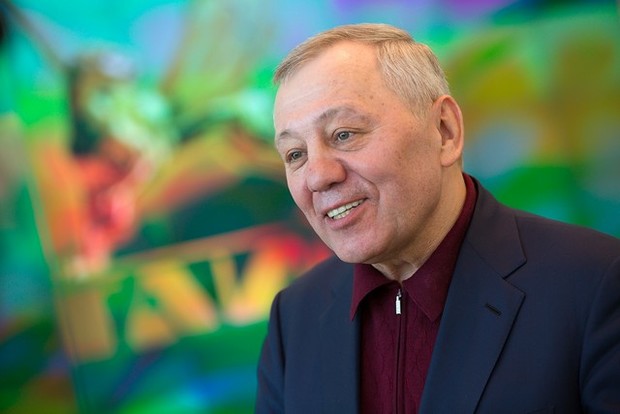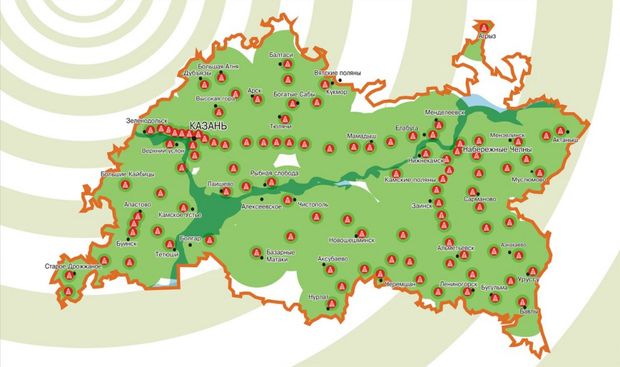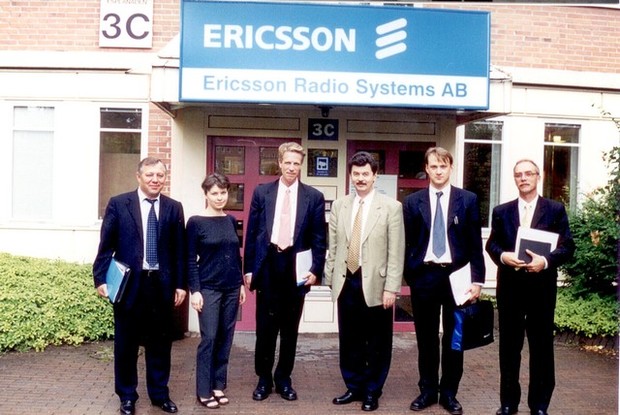Battle for subscribers, or How federal officials helped Santel to complete construction of cellular networks
The story of how at the beginning of 2000s the regional network entered the top five leading mobile operators in Russia
In the 2000s, TAIF entered with ambitious plans: to increase the subscriber base of the first Republican operator of GSM format Santel to 300 thousand people, to begin to develop the Internet as a service and to create a cable television with hundreds of channels. Achievable plans, by today's standards, but for that period — were simply unimaginable. Cell phones used to cost thousands of dollars, and Internet and cable television were not so widespread even abroad. About the big dream to change the information reality of the Republic, about the difficult search for new technologies and repeated modernization, about the confrontation with the federal officials in the struggle for created by TAIF modern telecommunication infrastructure in Tatarstan – in our today's report.
Demand for Santel services increased thirtyfold in two years
'In fact, the contribution of TAIF to the development in the Republic of GSM standard is huge,' said Director General of JSC State Mobile Communication Aleksander Leontyev. 'They were the first in the Volga region and the establishment of this progressive standard was due to the ideas and funds of TAIF. After the trunk communication with its phones, weighing a half of kilogram each, cellular communication of GSM standard became a big step in development.' The users interest appeared immediately. First 10 thousand subscribers of the company TAIF-Telkom, having been developing this network, it gained very quickly – in a year of work. Then the dynamics decreased to zero, and coverage of subscribers stopped at the achieved level. The management of TAIF started searching for new ways of development of the company. Having analyzed the situation, they realized that the problem was mental. 'In the movies, in the newspapers the mobile phone was positioned as a luxury,' says Director General of TAIF JSC Albert Shigabutdinov. 'Only rich people supposedly could afford it. Although we had started to offer low prices.'

Director General of TAIF JSC Albert Shigabutdinov: 'We purchased handsets at $10 million and distributed it for free. And by 2002, we had 300 thousand subscribers.'
Customers who had already become familiar with the mobile communication and got used to its convenience also began to appeal to TAIF, in particular, through the media with requests to do more affordable rates. Then the project Santel appeared – cheap mobile phone with flexible per-second payment system without the onerous subscription fee and with free SMS. This offer immediately made cellular communication affordable for most people. Besides, the company invested considerable funds to spread the service in a very unusual way. 'We purchased handsets at $10 million and distributed it for free,' says Albert Shigabutdinov. 'And by 2002, we had 300 thousand subscribers.' Indeed, the marketing campaign of Santel with low rates and free distribution of handsets generated considerable public excitement.
The demand precision of this marketing promotion was fantastic. Santel points of sales were stormed by crowds of people wanting to get mobile phones. In some days, a thousand boxes were sold. In January of 2001, it allowed TAIF-Telkom to take the first place in the national ranking of the mobile operators in terms of subscriber growth. Subscribers grew like mushrooms after rain.
As a result, the demand for cards with minutes Santel in Tatarstan exceeded all expectations. However, the flow of subscribers brought not only income but also new serious requirements to the service provider – demand forced the company to accelerate the construction of infrastructure and required constant increase in power.

Rush and another wave of modernization
The company began receiving complaints from subscribers on failures in the service work. Due to the activity of new subscribers the company's infrastructure quickly became overloaded. As Director General of the cellular network Santel Zarif Zakirov told that time, the company's business plan was not intended to such excessive growth of customers. He appealed to subscribers not only through the company's offices but also through the pages of the popular media: 'The thing is that the services of the cellular network Santel came to be in great demand by the people even beyond our most optimistic expectations. By the growth of the subscriber base since December of last year Santel ranked first in Russia among all operators. But the high pace of development requires the continuous capacity increase of the system. The existing switchboard during peak hours no longer copes with the number of subscribers. Therefore, at certain time intervals it is difficult to reach due to the fact that all channels are busy.'
All the major cellular companies had the same technical problems at different times. In 2000, only Kuban-GSM (Krasnodar) has faced with a 'collapse' associated with congestion. In the first half of 2001, a similar problem befall the operators of Kaliningrad, Novosibirsk, Stavropol, Nizhny Novgorod and other regions. Capital operators, like MTS and Beeline, also could not escape from such problems. In many cases, the operators not only increased the service price but also suspended the connecting of new customers to the network for some period.
TAIF-Telkom didn't suspend the connection of new subscribers, and resolved the problem in the spirit of the fundamental principles of the holding by buying and installing a new switchboard. This approach, as noted Director General of MGS Aleksander Leontyev, showed the distinction of TAIF as a company that care of Tatarstan and always keeps abreast. In 2001, the company started construction of new base stations of GSM-1800 standard.
The two standards allowed the TAIF successfully cope with increasing traffic due to rapidly increasing subscriber base. Due to correctly chosen development strategy in the winter of 2003 TAIF-Telkom entered the top five leading mobile operators in Russia for the largest subscriber base. The company took the leading position among other regions of Russia in coverage area of Tatarstan, having created the largest regional cellular network. A wide network of base stations covered almost the whole country, including all cities, towns, main roads and railways.

Santel provided its subscribers with services such as voice mail, short message service, conferencing, call feed, 'mobile office', including the transmission of faxes, as well as mobile Internet. The Santel clients used national and international roaming in more than 220 Russian cities and 73 countries. From the very beginning, TAIF-Telkom provided its subscribers with automatic national and international roaming. In order to ensure workers of budgetary spheres with reduced rates, the team of Albert Shigabutdinov was involved in the creation of the State Mobile Communication. At the beginning of 2000s, Santel provided a subscriber base of 10 thousand phone numbers with preferential rates for MGS. While an average cost of a minute for calls was 27 cents, officials, doctors, kindergarten teachers could call for 9 cents.
Tatarstan adjustments to the federal scenario
It would seem that a lot of work to create a whole market of cellular communication in the Republic had been carried out, the business was made, and it's time has come to rest on industry leader's laurels. However, during this period in the segment of communications a new trend appeared – the Moscow operators started active expansion in the regions. And, of course, in their development strategies a tidbit appeared – Tatarstan as the Republic with the powerful infrastructure according to the brand-new technologies with the using of the most modern equipment and with a huge potential subscriber base. Thanks to the TAIF, Tatarstan at that time was a region where mobile communication had long ceased to be a rarity. The local operator Santel was not inferior to the federal operators in technical equipment, facilities, marketing policies, the level of training. TAIF-Telkom company was ready to defend its position in the market without fear of the expansion of Moscow networks.
The company-pioneer in the regional market had clear position: the connection between operators is possible only due to a contract between them on network interconnection – it required to implement technical requirements of accession to the operator's network Santel. The logic is simple: if Moscow operators decided to enter the market with already developed telecommunication infrastructure, they, in their turn, need to build channels of communication for their subscribers so as not to create congestion at existing channels. However, new market players were not eager to invest in communications of Tatarstan: they have decided that they could enter the market on their own.
Albert Shigabutdinov, whose company in the past few years invested money and effort in the creation from scratch of the entire communications infrastructure, that built 'towers', purchased technology, urged the competitors to do the right thing and invest in building of additional infrastructure for the organization in distant districts of the Republic the direct or transit connections between networks, to expand and improve the basic digital station of mobile communication, and to help Kazan GTS and Tattelekom to replace old analog switches to digital ones at the fixed communication stations.

Instead, Moscow operators started to put a massive pressure, including through the popular media, stating that TAIF-Telcom cut off all contacts with rival GSM operators in Tatarstan. So their subscribers had to use a long-distance connection to call someone, that cost considerably more expensive.
In fact, nothing of that kind just could be, because to disconnect from the network only those could who were connected to it. TAIF waited patiently for the fulfillment of technical requirements. Then the competitors decided to involve an administrative resource. In their treatment, the State Communication Inspection of the Republic sent TAIF-Telkom the direction to connect the communication with the competitors. TAIF-Telkom responded that technologically, under current law, it was possible with the accretion of communication channels and with the signing of the agreement, since the access was given 'in accordance with the treaties with each other on the provision of communication services'. But Moscow operators was in no haste to sign such contract with TAIF-Telkom.
From bad to worse. The GSM operators increased the pressure through the Ministry of Communications of the Russian Federation, creating the impression that Tatarstan unreasonably did not allow them to network and put all sorts of obstacles. The Minister of Communications of that time personally called for Albert Shigabutdinov to Moscow and expressed his bewilderment. However, after listening to his position, the Minister was surprised to learn that Moscow operators could connect to a telecommunication infrastructure even the next day, but having fulfilled technical requirements in order to avoid an overload of on the existing channels of communication and a disconnection of current users from the network. The Minister had no questions anymore. So, defending their positions in a tough competitive war, the regional network managed to make adjustments in the common scenario and obtained co-investments in the development of information infrastructure of Tatarstan by Moscow operators.

Selling of telecommunication asset
Having strengthened its position in the cellular market, Santel was the biggest local company with 334 thousand of subscribers and 221 base stations. By 2003, the coverage of the cellular network TAIF-Telkom accounted to more than 98% of the territory of Tatarstan.
Having developed mobile trend and having gained the place among the leaders of the Russian telecommunications industry, TAIF was planning to sell its mobile business to federal mobile provider. 'We felt that TAIF has invested sufficient resources in this project to ensure its fulfillment. Our participation was no longer required for further development of the company – Santel financed itself and made a profit.
Therefore, we were not against the wishes of such a professional team, which was created in MTS, to repurchase our company, especially as no one will put mobile communications in a pocket and take away from Kazan,' recalls Albert Shigabutdinov. In April 2003, the shareholders of TAIF-Telkom sold its stake to the largest in Russia and Eastern Europe mobile operator MTS for $150 million, having received dividends from current activities.

The price suit MTS too, that had long eyes on the Republic. Commenting on the acquisition of Santel, MTS President Mikhail Smirnov said: 'We acquire a very successful and profitable company that is in the top ten Russian mobile operators, and significantly strengthens the position of MTS in the Volga region.'
This deal was beneficial to both sides. The MTS could 'have been legalized' in the Tatarstan market, without spending time on obtaining necessary licenses, by getting licenses of TAIF-Telkom'. And TAIF after the transaction accumulated strength and money for the development of other lines of business.
TAIF invested about $90 million in the creation and development of the cellular operator Santel, that paid off and brought a good profit. Having sold the operator with a good profit, TAIF became convinced one more time that the introduction of high technology, despite high costs, is the right and profitable thing. And most importantly – it benefits Tatarstan and can ensure the dynamic development of Tatarstan economy. That is why the company maintained the main vector of development – the development and implementation of high-tech projects in the fields of communication and later of radiotelecommunications in all following years. About these projects, about how TAIF managed to take a step beyond traditional telephone service and to provide residents of the Republic a window to the world of popular television, read in our next article.
Photos are provided by press centre of TAIF JSC